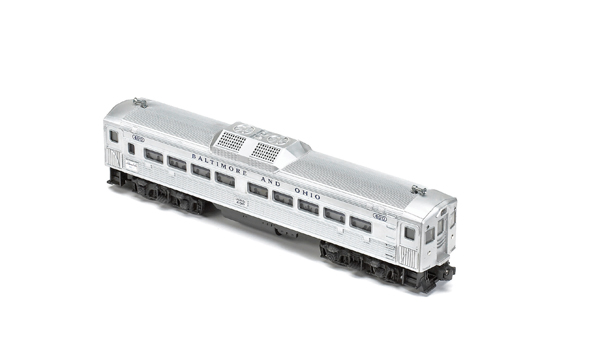Four years after the Budd Co.’s Rail Diesel Car made its debut in 1949, Auburn Model Trains announced the first O gauge model. This firm traveled the simplest path in 1953 when it installed a motor inside the shell of one of its streamlined passenger cars. AMT released Rail Diesel Cars in four road names.
Also in 1953, Gilbert created an engineering prototype of a Rail Diesel Car for its S gauge American Flyer line. This mock-up consisted of a cataloged plastic streamliner into which a motor had been crammed. For unknown reasons, Gilbert stopped at this point and never mass-produced a Budd car.
Marx proved to be more adventurous, and in 1956 it mass-produced an O gauge model of an RDC lettered for the Boston & Maine. This Budd car remained in the line for another three years. Decades later, K-Line and Ready Made Toys used the same tooling for their RDCs.

Time for Lionel to strike
Lionel waited until 1956 to put the finishing touches on an O gauge RDC. The No. 400 powered motorized unit departed from those earlier models because it did not use a body shell previously designed and manufactured. To the contrary, Lionel’s engineers developed a brand-new shell for their Budd car; also new were the window strips and the lens pieces. Plainly, expenses weren’t spared.
The 400 boasted two-axle Magne-Traction as well as a three-position reversing unit, along with three working lights. The Lionel Service Manual specifies that the motor installed on the RDC was the one from the No. 2028 Pennsylvania RR GP7 diesel (brought out in 1955). The 400 also borrowed its truck plate and collector arm from that Geep. The basic power truck came from the new No. 2328 Burlington GP7; the horn came from the no. 2367 Wabash F3.
Just the beginning
Lionel surpassed its rivals in other ways with its Baltimore & Ohio RDC. Besides creating a new shell instead of relying on an old passenger car, it expanded its roster of Budd cars. A second powered unit joined the 400 in 1957. And unlike the latter, which was based on Budd’s RDC-1 85-foot-long coach, the new No. 404 followed the design of an RDC-4 74-foot-long baggage-RPO car.
Besides having two powered B&O Rail Diesel Cars, Lionel released non-powered versions of both units in 1957 (Nos. 2550 and 2559). For that year, it also took the novel step of assembling a brand-new O gauge outfit (No. 2276W) that came with one 404 baggage-RPO and two of the 2559 coaches.
The 400 Budd car remained in the line through 1958. Lionel offered it as a separate-sale item and the motive power in a new Super O set: No. 2502W contained this powered RDC and one of each of the non-powered units.
Focus on silver
When acquiring a 400 RDC, make sure the silver gleams. This motorized unit, like all Lionel Budd cars, has a tendency to lose its sheen. The blue heat-stamped markings shouldn’t be scratched or marred, with the Baltimore & Ohio lettering, plus the numbers and nameplates (“Budd RDC-1”), being legible.
Lionel’s RDCs ought to run smoothly and pull a few other cars. Check that the horn still works and the couplers haven’t been damaged.
Lionel cataloged the No. 400 Budd Rail Diesel Car from 1956 through 1958.
Learn more about the prototype cars in our DVD.
Buyer’s Checklist:
- Broken or cracked plastic body?
- Scratched or faded paint or lettering?
- Damaged window strips?
- Bent or corroded knuckle couplers?
- Missing ornamental horns or lenses
- Functioning horn and headlights?
- Operates smoothly forward and reverse?














was a 404 and two 2550’s…so all I could do was run a “mail train”! Years later I found a 2559. Still have all four.
I think my father got a deal when he bought my RDC’S—all the hobby shop had left
I have both the 400 and the 404, along with one 2550 and two 2559’s. Makes a nice, smooth-running train. My question is, which way should the body be mounted on the frame, since it can be attached either way. Obviously, the underbody details are from a GP7 and are incorrect for an RDC. I put the full tank directly below the roof hump. I’d be interested in any comments.
I have a 400 in pristine condition but haven’t found the non powered models yet.